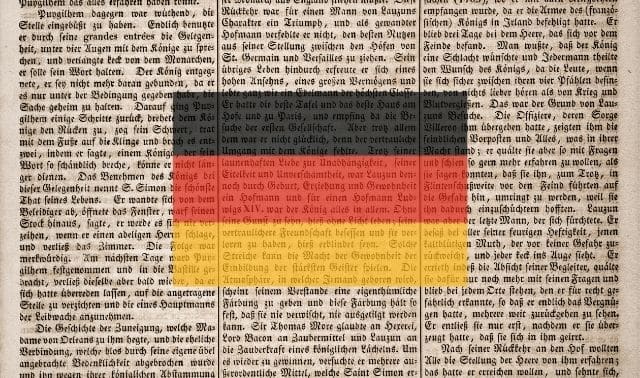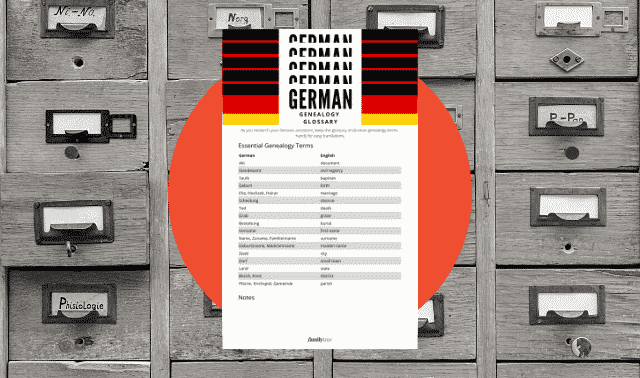Sign up for the Family Tree Newsletter Plus, you’ll receive our 10 Essential Genealogy Research Forms PDF as a special thank you!
Get Your Free Genealogy Forms
"*" indicates required fields

It’s been said that if you learn the complexities of English, such as the many spelling quirks and “rules that are exceptions to rules,” you will find learning German is a breeze because its spelling and pronunciation rules are much more predictable. English and German share the same linguistic roots (both are Germanic tongues, as opposed to the Latin-based Romance languages such as French, Spanish and Italian), and many words have similar spellings and pronunciations.
If you can arm yourself with a basic vocabulary of a few dozen words (you might want to call this “tombstone German” because many of the words you’ll need are found on the older, detailed German-language memorial markers, especially in America), you’ll be able to read many of the genealogical records that are written in German.
You’ll need some German language skills for: church records in both Europe and America; private certificates; courthouse documents such as wills and deeds; and newspapers and websites of German towns and archives. And if you can expand that knowledge to a few hundred words, you’ll be able to make sense of fairly complicated records and even have some rudimentary conversations in the German language.
German Language Basics
German grammar is somewhat more complicated than it is in English, but the amount of grammar you need to do your genealogy work is limited. A few key grammar principles to keep in mind:
- German is an “inflected” language, which means that its nouns carry suffixes determined by how the noun functions in a sentence (for instance, as the subject or the object of the sentence). The suffix changes the spelling of the noun (German nouns are also easy to pick out; they are always capitalized, even what we would call “common” nouns).
- Because of the inflections, the word order in German sentences may split a helping verb from the sentence’s main verb; the latter often will be found at the very end of the sentence.
- There are many dialects of German, which causes many spelling variations and differences in idioms.
The German alphabet has relatively few differences from that of English. Two major ones are:
- There is a character called the “S-set” that is used for a “double s” and looks like this: ß (often mistaken for for an upper case “B”).
- More importantly, many German vowels carry an Umlaut, shown as a pair of dots written over the vowels a, o, u and y. The Umlaut takes the place of an e (recently, German language officials have decreed that the e should be written out instead of using the Umlaut, but this is only in the process of gaining acceptance and of course the hundreds of years of records containing Umlauted words will not be affected). The major effect of the Umlaut is that it profoundly changes the pronunciation of the vowel and therefore may create radically different phonetic spellings of German names in America.
Another thing you’ll note in German records is that those writing them used abbreviations liberally (even to the point of abbreviating names) and used hypenations at the ends of lines of handwritten documents at any point in a word (not just between syllables, as is traditional in English).
Among the internet tools that will help you gain some language proficiency (or make up for what you’re lacking) are Google Translate and the leading online German-English dictionary, LEO Deutsch-Englisches Wörterbuch (German-English Dictionary).
Google Translate has a toolbar that will pop up above a German-language website and allow you to click on it for a translation of that site. The caveat here is that not all sites translate completely; sometimes, entire blocks of text do not translate and often the Google translations will give only a rough sense of the meaning in English. You can copy and paste any untranslated blocks of text into the text box on the Google Translate site. The LEO dictionary online is great for translating individual words. You can attempt entire sentences with it, but it may not help if the sentence is not constructed in correct German.
Printed Fraktur/Gothic Font
Until the early 1940s, all German-language printed material was published in a font called Gothic, or Fraktur. In German-speaking areas, newspapers, journals, genealogy surname books and family collections, the Meyers Gazetteer, the printed “boilerplate” found in church and civil registers as well as on private certificates and most tombstone inscriptions all used this font.
You’ve likely seen this font before because many newspaper nameplates still are printed in it. But it’s worth studying because it is a very difficult font to decipher with its many similar-looking letters. As a matter of fact, the font isn’t just difficult for the human eye; only within the last couple of years has optical-character recognition software been developed to allow for the scanning of German-language newspapers printed in the Fraktur/Gothic.
In uppercase letters, the most confusing letters are the S, which is often mistaken for C, E and G, and the interchange of the following pairs of letters: the V and B; I and J; and N and R.
In lowercase letters, h, n and y are difficult to differentiate; f and s look alike, as do c and e and i and j. The lowercase k can also cause confusion because it looks like a Roman font letter l with a line through it.
It’s helpful if you learn to differentiate the font’s lookalike letters and practice a two-step process in working such a text:
- Step 1: Write or type out the original German in handwriting or typing to which you are accustomed.
- Step 2: Use your transliterated text to make a translation from German to English (do this either from the German vocabulary knowledge you’ve acquired or by using an online tool).
Here’s an example of using the two-step process on a tombstone (slashes indicate the end of each line of inscription):
- Step 1: Transliterated from the Gothic font: Hier ruhet / Peter Kerschner / Sohn von / Phillip Kerschner und / Susanna eine geborne / Himmelberger. / Er war geboren / Den 11 Marz 1803, / Verheirathet sich am / 1 February 1824 mit / Catharina Bode. / Er starb / Den 30 January 1868 / und war alt / 64 Jahre, 10 Monate, 20 Tage / Leichen Text: 1 Buch Moses 48:20
- Step 2: Translated into English: Here rests / Peter Kerschner / Son of / Phillip Kerschner and / Susanna “a born” [nee] / Himmelberger. / He was born / the 11th of March 1803, / Married on / 1st February 1824 with / Catharina Bode. / He died / the 30th January 1868 / And was aged / 64 years, 10 months, 20 days / Funeral text: Genesis 48:20.
German Cursive Script
Reading handwritten records requires a few more degrees of skill. You must not only adjust from one individual’s script to another but also deal with slips of the writing pen and just plain awful handwriting. The handwritten records that you’ll deal with the most are church records, private certificates, wills, deeds and letters or diaries.
A good way to start learning German cursive script is to obtain a script key of a common “standard” handwritten script such as Kurrent or Sütterlein. The book If I Can, You Can: Decipher Germanic Records by Edna Bentz contains one of the best script keys. Bentz’s key displays a dozen or more variants for each letter of the alphabet.
After you have a script key, write your own surname (or that of an ancestor you’re seeking) as a guide for what to look for in handwritten records. You may need to write your name hangman style, constructing the word letter-by-letter, starting with those you know and then working to those letters that give you more difficulty. Some have likened the process to unraveling a code, only instead of using cipher substitutions, you’re putting that old-style handwriting into one you can better understand.
After writing out the name you’re seeking, the best way to learn how to decipher the script is to start with documents that use a limited vocabulary, such as church records or private certificates. As you gain more confidence in your work, you can gradually build toward more challenging records such as deeds and wills and eventually letters or diaries. But realize that even experts with years and years of experience will be uncertain at times because either the handwriting is ambiguous or the original records has deteriorated.
ADVERTISEMENT







